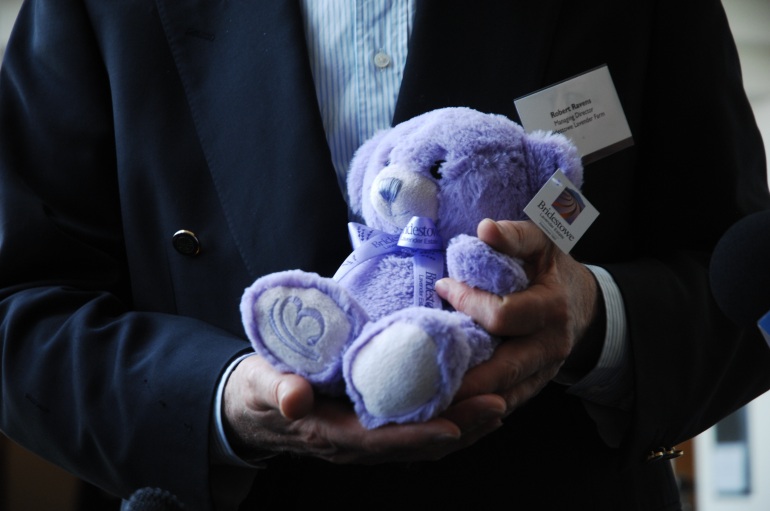Why China went bullish on Bobbie the bear

A man holds Bobbie the bear, hand-stuffed with lavender at Tasmania’s Bridestow Lavender Estate. (AP photo)
Bridestowe Estate is a beautiful patch of land, 263 acre large, and covered with lavender on the northern fringe of the Apple Isle. Lately, it has become a pilgrimage site for busloads of Chinese tourists thanks to its most famous inhabitant - Bobbie the bear.
Bobbie is a cute purple-coloured teddy bear stuffed with fine lavender and can also be converted into a virtual hot water bottle with the help of a microwave. It does not stop there. Bobbie has other mystical abilities including curing muscle, back and even period pains, if you believe Chinese social media.
The bear debuted in 2011, though he was popular with tourists, he was not one of the most sought-after items in China - the second largest inbound tourist market for Australia. However, Bobbie became an overnight sensation in China after it was endorsed by a string of famous Chinese actresses on social media including Sun Li and Fan Bingbing.
Sun and Fan are the two biggest celebrities on the Chinese silver screen – the Chinese equivalents of Angelina Jolie and Nicole Kidman. Pictures of them hugging Bobbie have sparked a frenzy amongst their followers. The Tassie lavender bear has become a must-have item for young women in China.
“Our phone system has gone into meltdown. We can’t put Bobbie on the internet because the demand just overwhelms our ability to supply on a daily basis,” Bridestowe managing director Robert Ravens told reporters at the Asia-Tasmania forum recently.
“It’s caused our staff to be stressed, it’s caused me to stressed and it means we can’t even take a holiday - they chase me all round the planet.”
Bridestowe’s website shows all Bobbies have been sold out - including one bear dressed in a purple Chinese-style satin jacket.
Hundreds of counterfeiters and dealers have sprung to life on the internet, peddling “Bobbie” to desperate buyers.
Bobbie-mania shows the power of social media in China. Despite a recent drop in usage numbers, Sina Weibo - the Twitter-like microblog - still has 280 million users. That’s not too far off the population of the United States. Fan Bingbing, one of the A-listers who has endorsed Bobbie, has 3.8 million followers on Weibo alone.
While Sina Weibo is losing a bit of steam, another social media platform Weixin – known outside of China as WeChat - is spreading like wildfire in China and abroad. Since its introduction in 2010, WeChat has more than 300 million users and enjoys a faster adoption rate than Facebook or Twitter. It has more than one million users in Australia.
In recent years, we have seen a large of number of businesses and even politicians rushing to climb abroad the new Chinese social media platforms such as Weibo and WeChat, with tourism boards around the country, universities, and airlines leading the charge.
Outgoing managing director of Tourism Australia, Andrew McEvoy said he expects there will be a shift in the focus of the organisation’s marketing campaigns from traditional advertising to digital and social media platforms.
“The effective use of digital and social media is the battleground for our sector,” he said.
“At the moment, we are spending 70 per cent in mainstream and above-the-line media, but 30 per cent in the digital space. In the next five to ten years, that will probably swap over completely.”
We all know word of mouth is the best way to advertise and the ascendency of social media has made that possible on a large scale. It is especially important for the fast-growing Chinese nation, which is projected to become a one million person and $10 billion market within the decade.
Two recent Tourism Australia campaigns that have been a stunning success in China show how effective social media campaigns can be. When Tourism Australia launched the “There’s nothing like Australia" campaign in June 2012, its promotional video was downloaded 23 million times worldwide including 20 million times in China.
Another Chinese–language promotional mini-series starring two Taiwanese actors was watched by more than 50 million people in China.
At the end of last year, Tourism Victoria also launched its own Chinese social media campaign that tapped into the large Chinese-Australian community in Victoria in an attempt to lure their families and friends to visit Australia.
Social media is a powerful marketing platform for Australian businesses who want to succeed in the China market. It is an especially useful tool for small and medium sized enterprises that don’t have large advertising budgets like multinationals.
Bobbie mania is a lesson for us all.
Follow Peter Cai on Twitter: @peteryuancai
Subscribe to the China Spectator newsletter: http://bit.ly/ChinaSpec
















